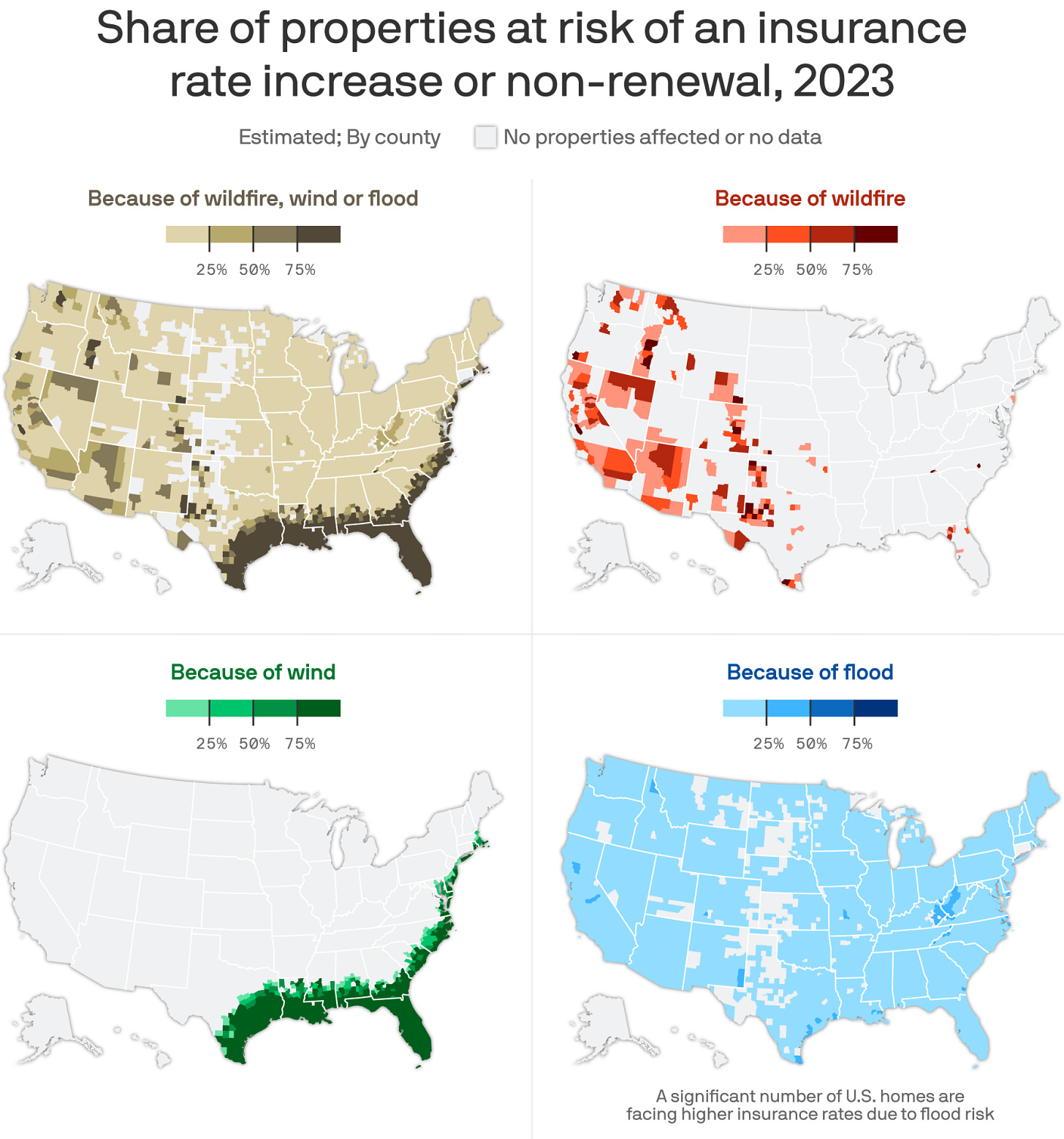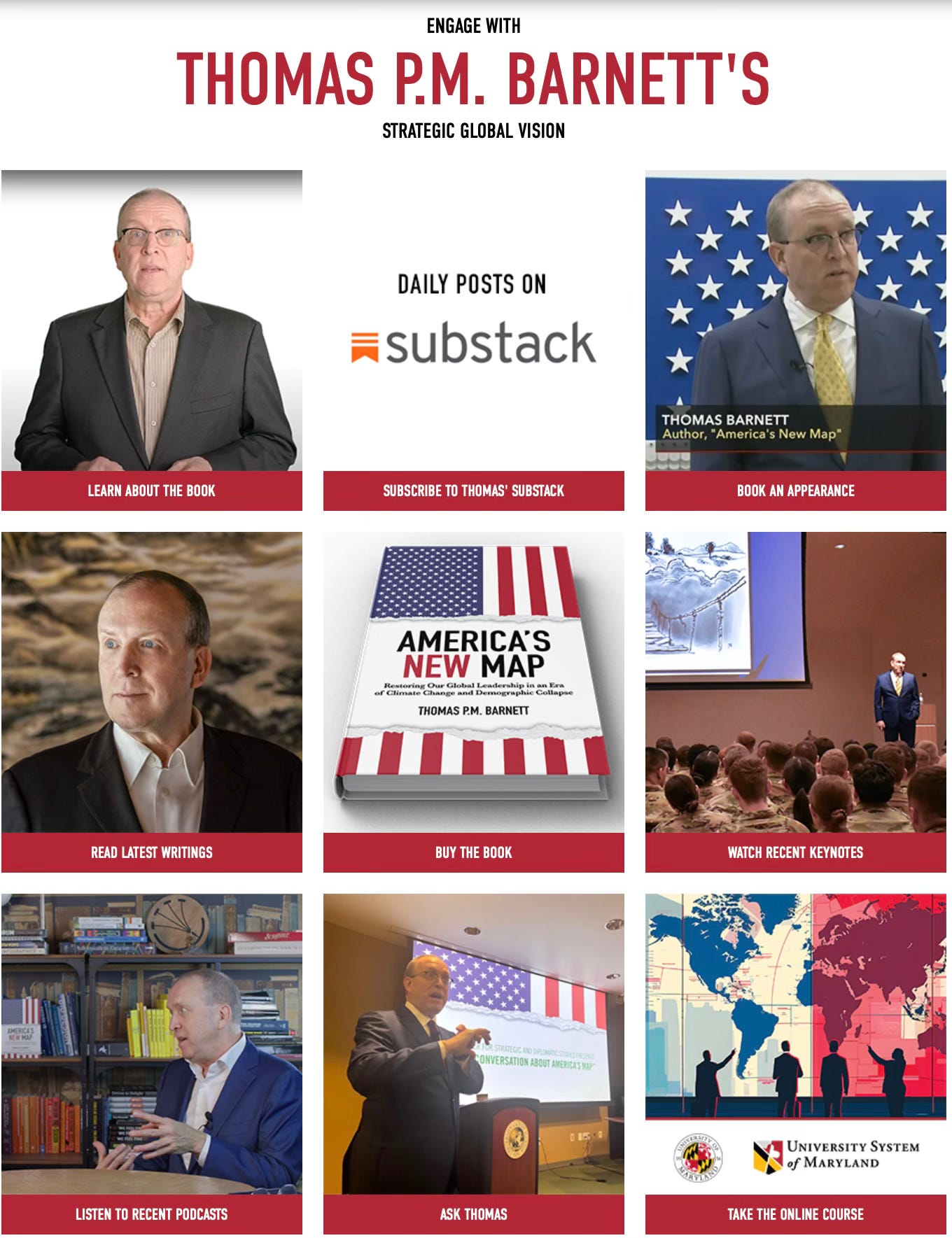1) From their mouths to Trump’s ears
FOREIGN POLICY: This Trump Administration Is Shaping Up to Be Latin America-First
The teaser/promise:
With a deep bench of regional experts at the helm, the United States can finally compete with China in the neighborhood.
Encouraging, to say the least, if you believe, as per Reagan quoted here, that “personnel is policy.”
Not to go unnoticed: our first Latino SECSTATE in Rubio and a former US ambassador to Mexico as DEPSECSTATE (Christopher Landau).
Of course, we had similar hopes with George W. Bush and — later — his little brother Jeb, but the former’s ambitions were detoured by 9/11 and the latter couldn’t get past Trump in 2016.
Naturally, any such talk of Trump focusing on Latin America for the better feels like an only-Nixon-can-go-to-China projection — i.e., wish fulfillment.
But we can dream, for now, can’t we?
So many administrations have had their strategic priorities hijacked by events. I guess the optimism here would center on Trump’s unique ability to make everything everywhere all about him all the time. That is one way to maintain control — sort of.
Then again, would-be norms-busters like Russia, China, and India might just be happy enough to sit back and let Trump bust some more without immediate comment or comeback. You definitely get that feeling when it comes to things like Trump threatening to take Greenland by “military force” — if necessary, even as I suspect that “force” would be all about America’s NATO spending/membership.
Still, you have to like the Rubio pick — at least on paper.
2) Where does one move to in a climate-challenged America?
AXIOS: Fires could force insurance overhaul
Force insurance overhaul … ya think?
I mentally aggregate these maps and I think the Upper Midwest is the best (surprise), and, with half of my household goods already in storage (don’t tell the James-Younger Gang) in Northfield MN, I’m running with that logic.
In truth, though, it all comes down to this for me and my spouse:
The more true the seasons, the shorter the windows of suffering.
Clearly, the Deep South is not for us (spouse lived in GA for a stretch), as we both love the cold. So, we’ll make do in less-stressingMN, leaving behind the air quality hellhole that is the Central Lowlands.
3) From Russia, with love
WAPO: As Russia seeks influence in Africa, former students play central role
Russia is the black sheep of the Superpower Five, no doubt, but one that definitely thinks in terms of North-South integration. The logic is sound: the Global South remains the most in-play and offers the most upside going forward.
The subtitle describes the legacy Putin seeks to leverage:
Going back to the days of the Cold War, thousands of Africans studied in the Soviet Union and later Russia. They’re now among Russia’s biggest boosters.
Meanwhile, US universities have been telling foreign students to get their asses over here before Trump’s inauguration — a different approach to global influence, to say the least.
Now comes the pay-off:
The young West African students touched down in what was then the Soviet Union knowing only a handful of Russian words and little about their new home.
Decades later, those former students — many of whom became doctors, engineers and businesspeople in West Africa — are key influencers for Russia as it vies with the West for sway in this turbulent part of Africa. In interviews in Burkina Faso, which has become a focus of Russian outreach, the former students said they are fostering economic, educational and diplomatic ties as they help their country move away from generations of working with the West and toward partnership with Russia.
Remember, one out of five humans in 2050 is African and half of them are young, making Africa the center of youth culture and consumerism mid-century and that is serious demand power to be accessed, shaped, and won.
Remember also, no superpower operating in Africa has to be perfect; they just have to be more tolerable than the rest.
4) We don’t need no stinkin’ treaties!
JUST SECURITY: The Rio Treaty’s Security Pact and Unintended Consequences of Threatening Canada, Greenland, and Panama
One of those you-better-check-the-fine-print things:
The legal obligations the second Trump administration may have vis-à-vis Canada, Greenland, and indeed Panama, refer to an older treaty that is a forerunner to NATO: the 1947 Inter-American Treaty of Reciprocal Assistance, also known as the “Rio Treaty,” of which the United States is a founding member.
It is an excruciatingly boring article worthy of its legalistic diplospeak, but, yeah, we signed it.
Conceived in the fires of World War II and built on such precedents as the 1939 Panama Declaration, the 1940 Havana Declaration, and the 1945 Act of Chapultepec – all instruments aiming to shield the Americas from the ongoing European conflict – the Rio Treaty has been characterized as the “multilateralization of the Monroe Doctrine” due to its overarching principle of continental solidarity in the face of an attack against any country located in the Western Hemisphere.
It’s that bit about a multilateralized Monroe Doctrine that attracted my attention. Putting aside the article’s intent to warn off Trump from any intra-hemispheric invasions (naturally justified, as we always do, by citing dangerous outside interference), I just like the notion that this natural building block of hemispheric integration is still on the books.
As always, I am all about opening the kingdom (EU approach) instead of taking prisoners (Russia’s approach).
Someone's knockin' at the door
Somebody's ringin' the bell
Do me a favor
Open the door and let 'em in
[Paul McCartney]
5) If I had a nickel for every time I worked for a tech startup that …
TECHCRUNCH: What are AI 'world models,' and why do they matter?
It is true: just about every start-up I’ve been associated with this century has had the same macro-ambition in mind: the ability to “boil the ocean” (all that Big Data) and figure out how the world works.
The current momentum:
World models, also known as world simulators, are being touted by some as the next big thing in AI.
AI pioneer Fei-Fei Li’s World Labs has raised $230 million to build “large world models,” and DeepMind hired one of the creators of OpenAI’s video generator, Sora, to work on “world simulators.” (Sora was released on Monday; here are some early impressions.)
But what the heck are these things?
World models take inspiration from the mental models of the world that humans develop naturally. Our brains take the abstract representations from our senses and form them into more concrete understanding of the world around us, producing what we called “models” long before AI adopted the phrase. The predictions our brains make based on these models influence how we perceive the world.
Is this not basically my entire life’s work/lifestyle?
Yes, yes it is, which is why I keep getting pulled into these efforts as a contextualizer/world-builder/explainer/translator.
The point of all this seems to be giving AI a sort of awareness of its place in the universe, per one expert quoted:
“We need machines that understand the world; [machines] that can remember things, that have intuition, have common sense — things that can reason and plan to the same level as humans,” [Meta chief AI scientist Yann] LeCun said. “Despite what you might have heard from some of the most enthusiastic people, current AI systems are not capable of any of this.”
Sure, video games are the near-term payoff, but bigger, far more important capabilities are in store for us, and we’ll need them to work climate change, meaning our adaptation to a changed climate.
Robots today are limited in what they can do because they don’t have an awareness of the world around them (or their own bodies). World models could give them that awareness, [Higgsfield CEO Alex] Mashrabov said — at least to a point.
“With an advanced world model, an AI could develop a personal understanding of whatever scenario it’s placed in,” he said, “and start to reason out possible solutions.”
Robots, of course, are only the pointy end of the spear.
6) Peak oil demand — not supply
REUTERS: China's oil consumption to peak by 2027, says top refiner Sinopec
Been saying this in print for decades: peak oil demand arrives long before peak oil supply.
Spent some time across the years with Sinopec. As throughout all of China, the only true strategic thinking one encounters is in the private sector. The government talks a lot of trash but actually engages in little serious thinking, being so tethered to the requirement of maintaining the Communist Party’s control above all else — truly, the little strategic mind killer.
Where a centralized government excels is in incentivizing macro-change it accepts as inevitable:
Driven by the shift towards electric vehicles and the rise of trucks fuelled by liquefied natural gas (LNG), the speed of China's move toward peak oil has taken the industry by surprise, with crude imports on track to peak as soon as 2025, analysts have said.
7) Don’t fear the reaper, baby I’m your drone
DEFENSE NEWS: Dutch army to equip its soldiers with personal drone-protection kits
This feels like the Dutch are attempting to de-frighten troops about the feasibility of operating in a drone hellscape!
The Royal Netherlands Army plans to equip its soldiers with personal drone-protection gear, including targeting lasers and portable sensors, in an effort to counter the threat of small unmanned aircraft systems that has transformed battlefields.
Just click it on there and you’re basically invisible!
The emerging reality:
Russian and Ukrainian troops battle under a constant buzz of drones that observe any movement, while first-person-view drones target individual soldiers on the move, in foxholes or through the hatches of armored vehicles. While Western armies are unfamiliar with such fighting conditions, they are rushing to adapt.
I bet they are.
Calling Radio Shack:
The Dutch plan to buy off-the-shelf equipment, and several suitable systems exist on the market … The ministry declined to provide details on which companies might supply the equipment.
Ssssh! It’s a secret!
Good luck with all that, I say.
8) The problem of trade-warring with your neighbors
VISUAL CAPITALIST: America’s Most Important Export Partners, by U.S. Jobs Supported
Big Auto and Big Oil are two tough domestic-job constituencies to cross, so we’ll see just how tough Trump can really be.
9) The OOPSd Loop
WAPO: Israel built an ‘AI factory’ for war. It unleashed it in Gaza.
Subtitle captures the fear:
Years before the Gaza war, Israel transformed its intelligence unit into an AI testing ground, triggering a debate among top commanders about whether humans were sufficiently in the loop.
Given the killing to be done and the collateral damage to be accepted, I gotta think the IDF is warming up to the idea that having a person in the loop ain’t actually so desirable — you know, the moral wear-and-tear of it all, as proven throughout history.
This feels like one of those dynamics where you know you’re going deeply unethical but you put off caring until utility is clearly established and the capabilities are suitably insulated from popular criticism.
Sort of an oops! I did it again! OODA loop — as in, hit them baby one more time!
It’s all so much easier when you zero out all the morality bits in the model. Let the algorithms work out all that crap.
Meanwhile, spread the gospel:
After the brutal Oct. 7, 2023, attack by Hamas, the Israel Defense Forces deluged Gaza with bombs, drawing on a database painstakingly compiled through the years that detailed home addresses, tunnels and other infrastructure critical to the militant group.
But then the target bank ran low. To maintain the war’s breakneck pace, the IDF turned to an elaborate artificial intelligence tool called Habsora — or “the Gospel” — which could quickly generate hundreds of additional targets.
What could go wrong?
Well, maybe half of the 45k Gazans you kill end up being women and children.
Outsourcing the tough calls:
Another machine-learning tool, called Lavender, uses a percentage score to predict how likely a Palestinian is to be a member of a militant group, allowing the IDF to quickly generate a large volume of potential human targets. Other algorithmic programs have names like Alchemist, Depth of Wisdom, Hunter and Flow.
Well, as long as they’re using cool names like that, then it has to be good.
The IDF even has an AI for estimated civilian casualties. That HAS to limit collateral damage, yes?
Not so fast:
In 2014, the IDF’s acceptable civilian casualty ratio was one civilian for a high-level terrorist, said Tal Mimran, a former legal adviser to the IDF. In the Gaza war, the number has grown to about 15 civilians for one low-level Hamas member and “exponentially higher” for mid- and high-level members,” according to the Israeli human rights organization Breaking the Silence, citing numerous testimonies from IDF soldiers. The New York Times reported the number as 20 earlier this week.
There has got to be some Old Testament story that yields the right ratio, I am thinking. I will check the Book of Wisdom of Solomon.
If all of this has a Minority Report-like “pre-crime” vibe to it, that’s only because that’s the natural spillover effect into policing. It starts with programs designed to predict suicide bombers (they’re going to die anyway) and will surely expand to wider preventative targets — if such capabilities are put in the right hands, or algorithms.
10) Just do it!
FOREIGN AFFAIRS: Why South Korea Should Go Nuclear — The Bomb Is the Best Way to Contain the Threat From the North
Couldn’t agree more.
One-sided or lop-sided nuclear standoffs are dangerous; symmetrical one-on-one variants are not.
History is entirely clear on this score.
11) India steps into the major leagues
WAPO: In India’s shadow war with Pakistan, a campaign of covert killings
It’s what superpowers do nowadays— a sort of quantum unilateralism. You don’t invade the country, you just cross over and kill a certain somebody and leave it at that.
Born of America’s Global War on Terror and Dick Cheney’s One-Percent Doctrine, our modeled behavior has spread — frankly, as it should.
It is a pressure-relief valve that is far more tolerable and far less destabilizing than more macro-level approaches.
There is morality in avoiding even greater immoralities.
Recall your Trolley Problem (best explored in The Good Place episode of the same name):
12) Trump recognizing climate change through the attic
NYT: Trump Wants Greenland and the Panama Canal. It’s About Climate.
Just a good summary of the actual underlying logic of Trump’s talk about Greenland, the Panama Canal, and — actually — Canada itself.
The thing that links them all is climate change, and climate change is all about real estate — as in, good land ruined (Global South, or my Middle Earth) and inaccessible land made accessible (Arctic North).
Trump turning America First into Americas First is not surprising to this author:.
I’ll have my own 1,400-word take on Trump’s tough talk regarding Canada, Greenland, and Panama early this week (probably Tuesday) on Politico. They asked, based on my recent writing, and I penned on Thursday of last week.























Does Trump think strategically, or does he just covet real estate? I contend that he covets his neighbor's land, along with his neighbor's wife and ass.